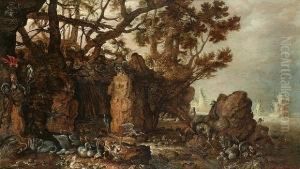Jan, Hans Ii Savery Paintings
Hans II Savery, born in 1589 in Kortrijk or Courtrai, which was part of the Spanish Netherlands (now Belgium), was a Flemish-born Dutch Golden Age painter, draughtsman, and a member of the prominent Savery family of artists. His family, including his uncle Roelandt Savery and his brother Jacob Savery, were significant figures in the development of Dutch and Flemish art during the transition from the late Renaissance to the early Baroque period. The Savery family's artistic legacy spans several generations, contributing notably to the Northern Renaissance and the Dutch Golden Age's rich tapestry of artistic achievements.
Hans II Savery's career flourished in the early 17th century when he moved to the Dutch Republic, seeking the vibrant artistic community and the burgeoning market for art in cities like Utrecht and Amsterdam. His works often depicted landscapes, still lifes, and mythological themes, showcasing his adeptness at integrating intricate detail with the broader, atmospheric effects that characterized Dutch Golden Age painting. Like his uncle Roelandt, Hans II was particularly noted for his contributions to the development of landscape and animal painting, genres that were gaining popularity among the Dutch middle and upper classes.
Throughout his career, Hans II Savery's style exhibited the influence of his familial artistic lineage, yet he also incorporated elements from other contemporaries and the evolving tastes of the period. His landscapes, often populated with exotic animals and fantastical elements, reflect the period's curiosity about the natural world and the far-flung territories being explored and colonized by European powers. This combination of detailed natural observation with imaginative composition became a hallmark of his work, blending realism with fantasy in a way that captivated his audience.
Despite the prominence of the Savery family in the art world of their time, detailed records of Hans II Savery's life and work are somewhat scarce, as is common with many artists of the era. However, his surviving works and the mentions of him in contemporary accounts provide insight into a skilled artist who was able to carve out his own niche within the competitive and rapidly changing landscape of 17th-century Dutch art. Hans II Savery's death in 1654 marked the end of an era for the Savery artistic dynasty, but his contributions, along with those of his relatives, remain significant in the study of Northern Renaissance and Dutch Golden Age art.







